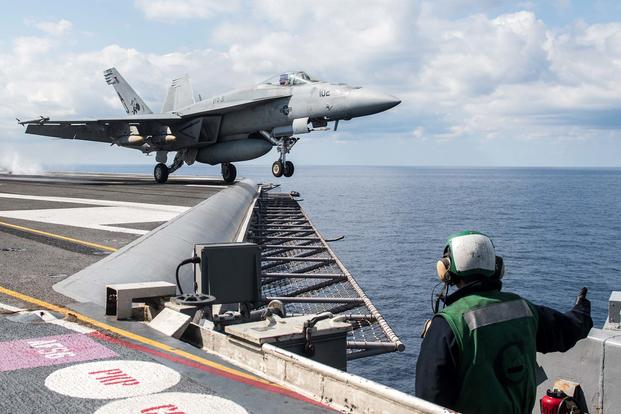The first U.S. pilot to notch an air-to-air kill in nearly 20 years, shooting down a Syrian Su-22 Fitter earlier this summer, recently made his first public comments about the experience, telling British journalists the entire encounter lasted only eight minutes.
The shoot-down was executed by Navy Lt. Cmdr. Michael "MOB" Tremel, an F/A-18E Super Hornet pilot assigned to Strike Fighter Squadron 87 aboard the carrier George H.W. Bush, reports outlet SavetheRoyalNavy.org.
The site reported that Tremel described the mission to reporters during a press availability aboard the Bush while it was in the Solent, a strait separating mainland England from the Isle of Wight.
Related content:
- US Navy F/A-18E Shoots Down Su-22 Over Syria
- F-15E Shoots Down Another Armed Drone in Syria
- General: Pilots Made Call to Shoot Down Syrian Aircraft
"I did not directly communicate with the Syrian jet, but he was given several warnings by our supporting [E-3 Sentry Airborne Early Warning and Control] aircraft," Tremel said, according to the report. "So yes, we released ordnance and yes it hit a target that was in the air, but it really just came back to defending those guys that were doing the hard job on the ground and taking that ground back from ISIS."
Officials with U.S. Central Command have said the June 18 engagement took place after the Su-22 dropped bombs near Syrian Democratic Forces fighters south of Tabqah. The aircraft was immediately shot down in accordance with rules of engagement and in defense of partnered forces on the ground, officials said.
According to reports, the Super Hornet initially launched an AIM-9X Sidewinder Missile at the Fitter, but missed. The aircraft next fired off an AIM-120 AMRAAM medium-range missile, which hit its target.
Tremel told media that he hadn't personally seen the Syrian pilot eject, but his wingman, who has not been identified, saw his parachute.
According to the report, Tremel downplayed his own historic moment in the overall fight.
"When you think about the shoot-down, in the grand scheme of things ... we flew over 400 missions in support of friendly forces on the ground," he said, referring to the VFA-87 Golden Knights.
The Bush, which deployed from its Norfolk, Virginia, homeport in January, has been conducting airstrikes against Islamic State targets in Iraq and Syria ever since. The carrier is wrapping up its deployment and preparing to return home. Another freshly deployed carrier, the Nimitz out of Kitsap, Washington, began launching airstrikes against ISIS from the Persian Gulf in late July.
As Military.com reported in late June, Tremel independently made the call to shoot down the Syrian aircraft based on established rules of engagement, according to Air Force Brig. Gen. Charles Corcoran, commander of the 380th Air Expeditionary Wing. Two Air Force F-15E Strike Eagle pilots made similarly independent calls in June to shoot down Syrian drones threatening coalition forces.
-- Hope Hodge Seck can be reached at hope.seck@military.com. Follow her on Twitter at @HopeSeck.

























